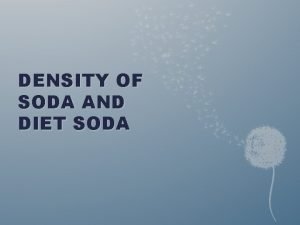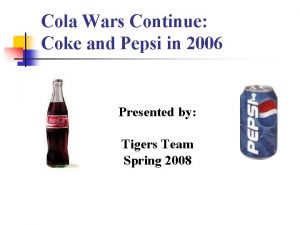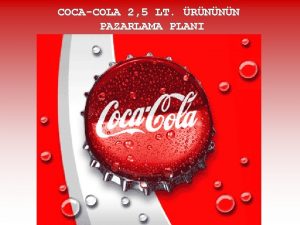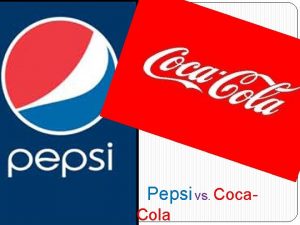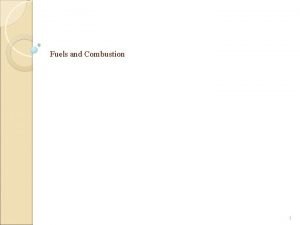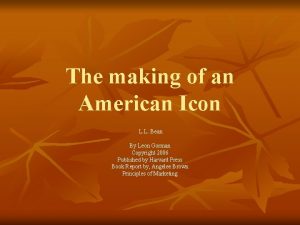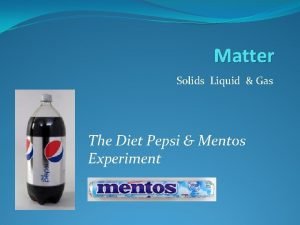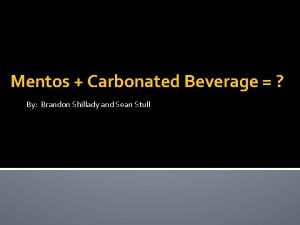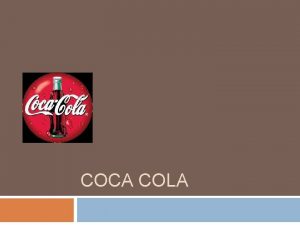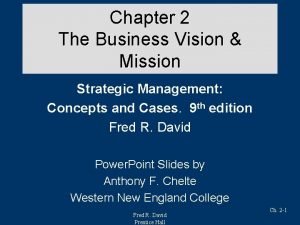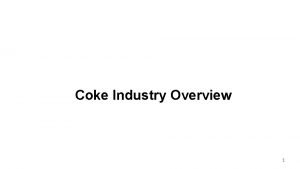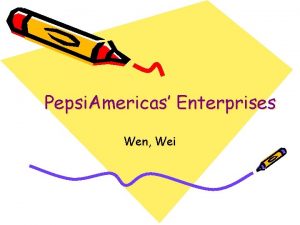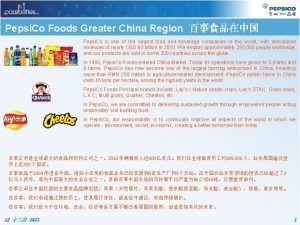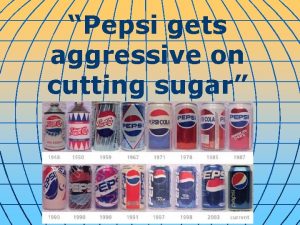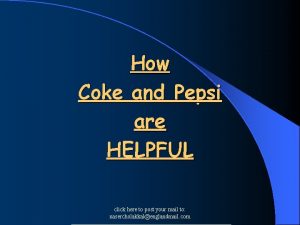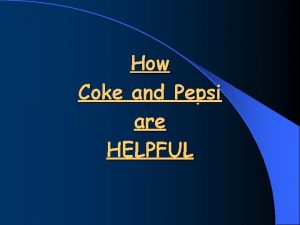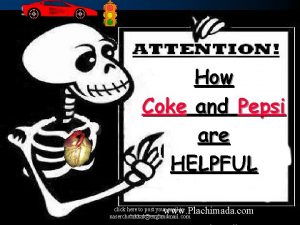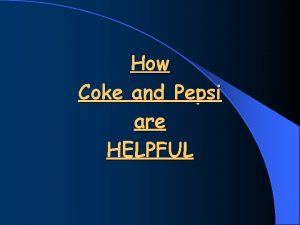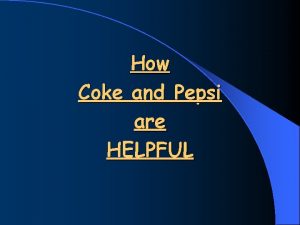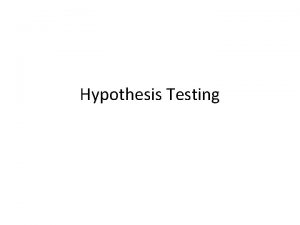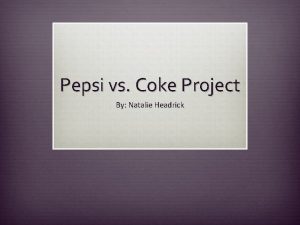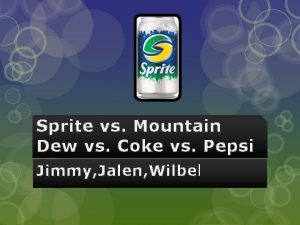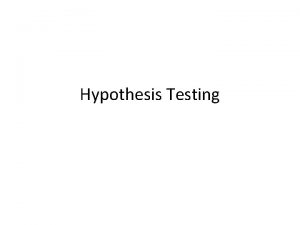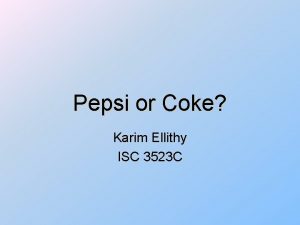Cola Wars Continue Coke and Pepsi in 2006


















- Slides: 18

Cola Wars Continue: Coke and Pepsi in 2006 Presented by: Tigers Team Spring 2008

Overview n History n Historical Industry Profitability n Concentrate vs. Bottler Profitability n Competition between Coke and Pepsi n Sustaining Profits

History of Pepsi n n n Pepsi was created in 1893 in North Carolina by Pharmacist Caleb Bradham. By 1910 Pepsi had built a network of 270 bottlers. Pepsi struggled and declared bankruptcy twice During Great Depression grew in popularity due to price decrease to a nickel. In 1938, Coke sued Pepsi-Cola brand for infringement on Coca-Cola’s trademark.

History of Coca-Cola was formulated in 1886 by pharmacist John Pemperton who sold the product at drug stores as “potion for mental and physical disorders. ” n. In 1891, Asa Candler acquired the formula, established a sales force and began brand advertising of Coca-Cola. n. In 1919, went public under control of Robert Woodruff expanded and developed in national and international markets. n. Successful during WWII with the high CSD consumption from the U. S soldiers. n

Industry Profitability: Porter’s Five Forces n Rivalry n Substitutes n Coke n Alliances n Pepsi n Acquisitions n Cadbury n Product Innovation

Porter’s Five Forces (Cont. ) n Barriers to Entry n Power of Suppliers n Exclusive Territories n Sugar n Substantial Investment n Packaging n Current Market Presence

Porter’s Five Forces (Cont. ) n Power of Buyers n Super Markets n Vending n Convenience and Gas n Fast Food n Mass Merchandisers § n Fountain Profitability of the CSD Industry

Concentrate Business vs. Bottling Business Concentrate Producers n n n Blend raw material ingredients Packaged Mixture in plastic canisters Shipped to bottlers Diet CSDs n Added artificial sweeteners

Concentrate Business vs. Bottling Business Bottlers n n Purchased Concentrate Added carbonated water and high fructose corn syrup Bottled CSD product Delivered to customers accounts Diet CSDs n Added sugar or high-fructose corn syrup

Concentrate Business vs. Bottling Business n Concentrate Producer n n Little Capital Investment Cost of $25 million - $50 million One plant to serve US Significant costadvertising, promotion, market research and bottler support n Bottlers n n n Capital Intensive High-speed production lines Bottling costs $4 million to $10 million Capacity of $40 million warehouse cost $75 million Coke and Pepsi each require 100 plants Pressure from Coke/Pepsi

Bottler Consolidation §Bottler plants decreased in the US § 2000 plants to 300 from 1970 -2004 §Coke’s re franchising bottling operations §Buying Poor managed bottlers §Infusing with capital §Selling to large bottling plants • In 1985, Coke purchased two of the largest bottling companies §Vertical integration

Affects on Industry’s Profits n n n Coke was the first concentrate producer to build a nationwide franchise bottling network, that Pepsi and Cadbury Schweppes followed suit. Franchise agreements with both Coke and Pepsi allowed bottlers to handle the non-cola brands of other concentrate producers. Bottlers could not carry directly competing brands.

Affects on Industry’s Profits (Cont. ) n n Throughout the 1980 s, the growth of Coke and Pepsi put a squeeze on smaller concentrate producers Shelf space for small brands declined and were shuffled from one own to another.

Affects on Industry’s Profits (Cont. ) n n In a five year span, Dr Pepper was sold several times, Canada Dry twice, Sunkist once, Shasta one, and A&W once. Phillip Morris acquired Seven-UP in 1978 for a big premium, but racked up huge losses in the early 1980 s, and then left the CSD business in 1985.

Affects on Industry’s Profits (Cont. ) n n In 1990 s, through a series of strategic acquisitions, Cadbury Schweppes became third-largest concentrate product. Coke has a world market share of 51. 4%, Pepsi has 21. 8% and Cadbury Schweppes has 6%

Sustaining Profits n n Shift to non-carbonated beverages (keep up with demand of health conscious society) Continue on current path and see where it leads

U. S. Liquid Consumption Trends

 Coke vs diet coke density lab report
Coke vs diet coke density lab report Cola wars continue
Cola wars continue Pepsi vs coke marketing strategy
Pepsi vs coke marketing strategy 4-2 reading quoting paraphrasing and summarizing
4-2 reading quoting paraphrasing and summarizing Coca-cola ürün yaşam eğrisi
Coca-cola ürün yaşam eğrisi Brad's drink pepsi
Brad's drink pepsi Thomas coke 8th earl of leicester
Thomas coke 8th earl of leicester Coke countable or uncountable
Coke countable or uncountable Otto hoffman's method
Otto hoffman's method Lemonade countable or uncountable
Lemonade countable or uncountable Was diet coke
Was diet coke Coke coffee
Coke coffee Killer coke
Killer coke Neocolonialism
Neocolonialism Share a coke with lisa
Share a coke with lisa What state of matter is pepsi
What state of matter is pepsi Mentos and diet pepsi
Mentos and diet pepsi Organigrama de pepsi
Organigrama de pepsi Pepsi mission statement
Pepsi mission statement
